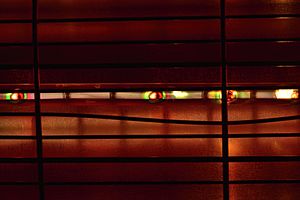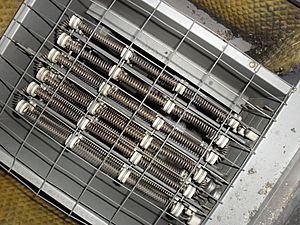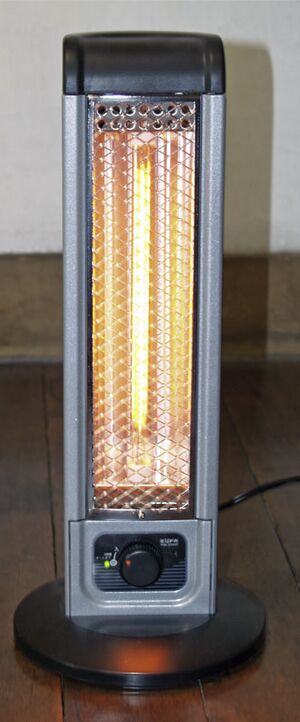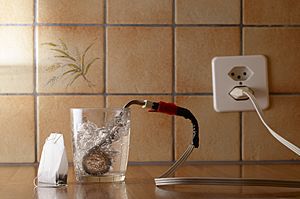Electric heating facts for kids

Electric heating is when we turn electrical energy into heat. It's used for many things, like warming up rooms, cooking food, heating water, and in factories. An electric heater is a device that changes electricity into heat. Inside every electric heater is a special part called a heating element. This element is like a resistor, and it works because of something called Joule heating. This means when electricity flows through the resistor, it creates heat. Most modern electric heaters use a special wire called nichrome for this.
Sometimes, a different device called a heat pump is used. It uses an electric motor to move heat from one place to another. For example, it can take heat from the ground or outside air and bring it inside to warm a building. Some heat pumps can even work in reverse to cool a building!
Contents
Warming Up Spaces
Space heating is all about making the inside of buildings warm and cozy. Electric heaters are great for places where it's hard to control the air, like in a science lab. There are a few different ways electric heaters warm up a space.
Infrared Heaters
Electric infrared heaters have parts that get very hot. These parts often look like a light bulb and have a reflector to send the heat in a certain direction. They send out infrared radiation, which is a type of light we can't see. This radiation travels through the air until it hits something, like you or a chair. When it hits, it turns into heat and warms up that object directly, instead of warming the air around it. This is why they are good for places where cold air might be blowing, like a garage. They are also good for heating just one spot.
Infrared heaters are quiet. You should always be careful with them and make sure they are not too close to curtains or other things that could catch fire. In some places, these heaters are called "electric fires" because they used to replace old fireplaces.
Convection Heaters
A convection heater warms the air directly around its heating part. Hot air is lighter than cold air, so it rises. As the hot air rises, cooler air moves in to take its place, gets heated, and then rises too. This creates a flow of warm air that moves around the room, making the whole space warmer. Some of these heaters are filled with special oil or fluid. They work well for heating a closed room. They are also quiet and generally safer than radiant heaters if they accidentally touch furniture.
Fan Heaters
A fan heater is a type of convection heater that has an electric fan inside. The fan blows air over the hot heating element, which helps to spread the warm air around the room much faster. They can be a bit noisy because of the fan. They are good for heating small rooms quickly and are often portable.
Storage Heaters
Storage heaters are designed to save money on electricity. They work by using cheaper electricity, often available at night when fewer people are using power. They store this heat in special clay bricks. Then, during the day, they slowly release the stored heat into the room. Newer storage heaters can be used with different electricity plans. They also have thermostats or sensors that can tell how warm the room is and adjust how much heat they let out.
Water can also be used to store heat in some systems.
Underfloor Heating
Underfloor heating systems have heating cables hidden under the floor. When electricity flows through these cables, they warm up the floor. A thermostat helps control the temperature, turning the heat off when the floor reaches the right warmth. The warm floor then radiates heat upwards, warming people and objects in the room. This makes the room feel comfortable even if the air temperature is a bit lower.
There are also systems that use hot water pipes under the floor instead of electric cables. Both types of underfloor heating can take a while to warm up or cool down. Newer electric systems can be placed right under the floor covering, making them respond faster to changes in weather or when you need heat.
Heat Pumps
A heat pump uses electricity to move heat from one place to another. It can take heat from the outside air, the ground, or even water, and bring it inside to warm your home. Imagine it like a refrigerator, but in reverse! In summer, it can also work the other way, taking heat from inside your home and moving it outside to cool things down.
Heat pumps are very efficient because they move heat instead of creating it directly. For example, ground source heat pumps use the steady temperature of the ground, which can be warmer than cold winter air. The EPA says that these pumps can save a lot of energy compared to regular electric heaters. Even though they might cost more to buy at first, they can save you money on electricity bills over time, especially if you also need air conditioning.
Heating Liquids
Immersion Heaters
An immersion heater has an electric heating part that goes directly into water or other liquids to warm them up. Small, portable immersion heaters might not have a thermostat, so you need to watch them carefully.
For heating water in homes or factories, immersion heaters are often placed inside an insulated hot water tank. A thermostat controls the temperature. Home units might use a few kilowatts of power, while industrial ones can use much more. If electricity is cheaper at certain times, like overnight, hot water can be heated and stored for later use.
Electric showers and tankless water heaters also use immersion heaters. These turn on when water flows through them and can heat water very quickly. They usually use a lot of power, from 3 to 10.5 kilowatts.
Sometimes, minerals in the water can build up on the heating element, like a hard crust. This can make the heater less efficient. Cleaning the heater regularly can help.
Circulation Heaters
Circulation heaters, also called "direct electric heat exchangers," have heating elements placed inside a pipe or container where liquid or gas flows. All the heat made by the electric heater goes directly into the liquid or gas. This makes electric heaters 100% efficient at turning electricity into heat. These heaters are used in factories to warm liquids and gases for different processes.
Electrode Heaters
With an electrode heater, there's no wire. Instead, the liquid itself acts as the part that resists electricity and creates heat. Because this can be tricky, there are very strict rules about how electrode heaters are used to make sure they are safe.
Electric Heating and the Environment
When we talk about how efficient electric heating is, it depends on what we include. For a home, an electric heater is 100% efficient because all the electricity you buy turns into heat. However, if we think about how the electricity is made at a power plant, the overall efficiency can be much lower. For example, a power plant that burns fossil fuels might only turn 30% of the fuel's energy into electricity. So, even though your electric heater is 100% efficient, a lot of fuel was used to make that electricity.
This is why some countries have different rules about electric heating. In Sweden and Denmark, for example, there are limits on using direct electric heating in new buildings because of how the electricity is generated.
However, if the electricity comes from a clean source like hydroelectric dams, nuclear power, or wind power, then electric heating can be a very good choice for the environment. For example, in Quebec, Canada, most electricity comes from hydroelectric dams, which produce very few greenhouse gases. Because of this, electric heating is very popular there.
Using heat pumps is also a great way to make electric heating more environmentally friendly. They use much less electricity than regular heaters because they move heat instead of creating it.
Money Matters with Electric Heating
Using electric resistance heaters to warm a whole area for a long time can be expensive in many places. However, if you only need to heat a small area or for short periods, electric heaters can actually save you money. This is because you can control them very precisely.
For example, a lunchroom in an office might only need to be warm during lunch hours. For the rest of the day, the main heating system can keep it cooler. Then, from 11:00 AM to 2:00 PM, a small electric heater can quickly warm the room to a comfortable temperature. This saves energy because you're not heating the whole room all the time.
To figure out the cost, you can multiply the price of electricity per kilowatt-hour by how many kilowatts your heater uses. For example, a 1500-watt heater (which is 1.5 kilowatts) running for an hour at 12 cents per kilowatt-hour would cost 1.5 x 12 = 18 cents per hour.
Electric Heating in Factories
Electric heating is used a lot in factories and industries.
One big advantage is that you can control the temperature and where the heat goes very precisely. You don't need to burn fuel, and you can reach very high temperatures that are hard to get with burning things. Electric heat can be aimed exactly where it's needed, even in small areas. Electric heating equipment can be made in any size and placed anywhere in a factory. It's usually clean, quiet, and doesn't release much extra heat into the surroundings. Also, electric heating systems can respond very quickly, which is good for fast production lines.
The main downsides are that electricity can be more expensive than burning fuel directly, and the equipment itself can cost a lot. However, factories might save money overall by using less energy to get the same results.
When designing an industrial heating system, engineers think about how hot it needs to get, how much heat is needed, and the best ways to move that heat. Besides conduction, convection, and radiation, electric heating can also use electric and magnetic fields to heat materials.
Some ways electric heating is used in industry include:
- Resistance heating: Like the heaters in your home.
- Electric arc heating: Using a very hot electric spark.
- Induction heating: Using magnetic fields to heat metal.
- Dielectric heating: Using electric fields to heat non-metals.
Sometimes, electricity is applied directly to the material being heated, like in arc welding. Other times, heat is made inside the material itself.
Industrial heating jobs can be put into three groups:
- Low-temperature (up to about 400°C or 750°F): Used for baking, drying, soldering, and shaping plastics.
- Medium-temperature (between 400°C and 1150°C or 750°F and 2100°F): Used for melting plastics, treating metals to make them stronger, and shaping non-metals.
- High-temperature (above 1150°C or 2100°F): Used for making steel, welding, melting metals for casting, and preparing some chemicals.
Images for kids
See also
 In Spanish: Calefacción eléctrica para niños
In Spanish: Calefacción eléctrica para niños






